Do you want a small flowering plant that you can keep anywhere easily? Check out all the details on How to Grow Pinwheel Flowers!
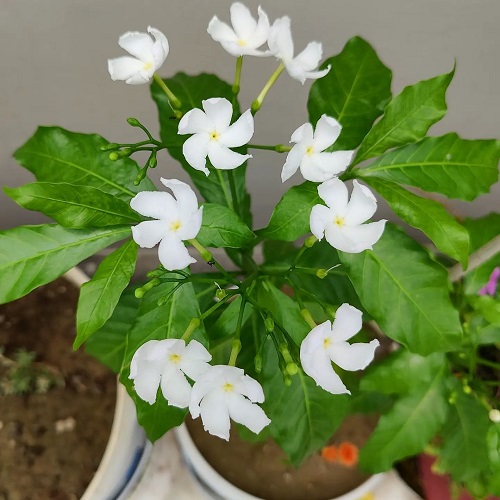
Crepe Jasmine is a beautiful plant when it comes to glossy foliage and matching clusters of white flowers. If you too want it in your plant collection, then read on to learn all about How to Grow Pinwheel Flowers!
Common Names: East India Rosebay, Tagar Tree, Tagar Plant, Chandni Flower, Moon Beam, Paper Gardenia, Single crepe gardenia, Flowers-of-love, Adam’s apple, Nero’s Crown, or Carnation of India
Botanical Name: Tabernaemontana divaricata
Discover Jasmine Plant Benefits
About Pinwheel Jasmine
Pinwheel Flower or Crepe Jasmine (Tabernaemontana divaricata) is an evergreen perennial flowering shrub from Northern India. The shrub produces milky-white flowers that open in a Pinwheel-shape over pointed, dark green, shiny leaves. It is widely grown as a hedge plant, and while planted in pots, you can make a bonsai by branch and root pruning.
Crepe jasmine grows up to 4-12 feet in height with 3-6 feet of spread.
Note: Crepe Jasmine is not a real Jasmine.
Explore Indoor Jasmine Varieties to Grow
Best Pinwheel Jasmine Varieties
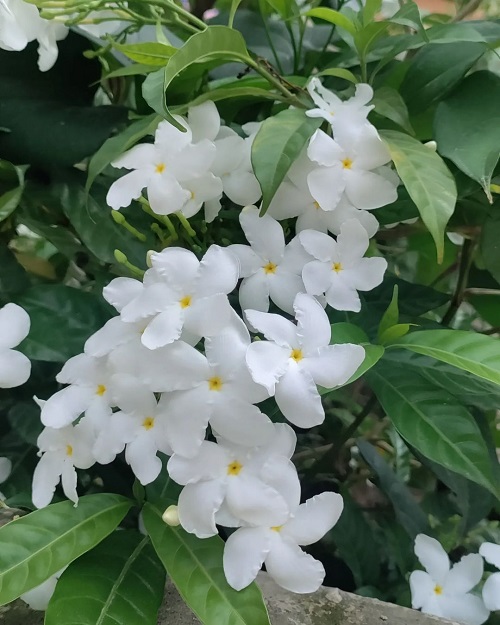
Mainly, there are two varieties of pinwheel jasmine – single and double-flower. Both of them carry white blooms. Single-flowered cultivars are fragrance-free, whereas the double-flowering variety offers a soothing light aroma.
- ‘Grandifolia‘ offers double blooms and large leaves.
- ‘Flore Pleno‘ (Fleur-d’amour or butterfly gardenia) has clusters of lacy pure white double flowers and narrow, wavy foliage.
Check out Types of Jasmine Flowers
Landscape Uses of Pinwheel Jasmine
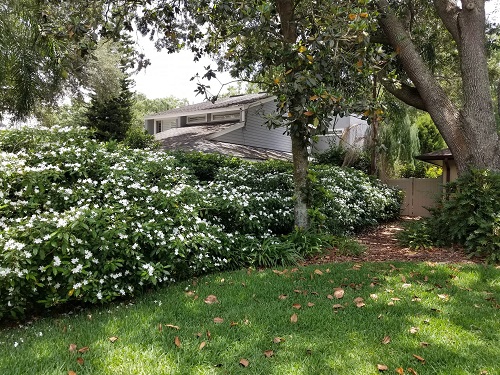
It can be grown as a hedge or shrub border screen when planted 3-5 feet apart. You can also use charming blooms and glossy foliage in background plantings. Over the course of time, it will turn into a small tree. It can also be a great hedge plant.
Look at the Cordyline Hot Pepper Plant Information and Landscaping Uses
Propagating Crepe Jasmine
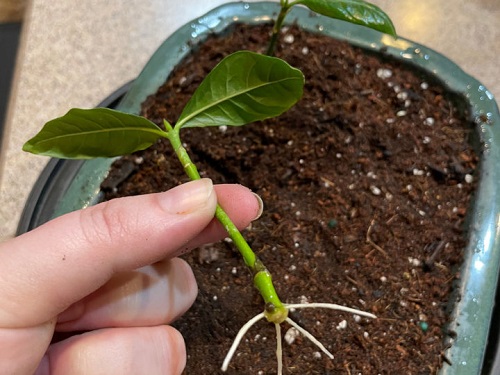
Propagate crepe jasmine using 4-6 inches of stem cuttings and take them from partially mature wood of the existing season’s growth. Fill the pot with river sand and coco peat in equal parts. Apply rooting hormone to the ends of the cuttings and plant them. Keep the pots in the shade and water them frequently, but avoid overwatering.
In 3-4 weeks, the cuttings can be replanted.
Note: The appropriate time for propagation is during the rainy or spring seasons.
Requirements for Growing Pinwheel Flower
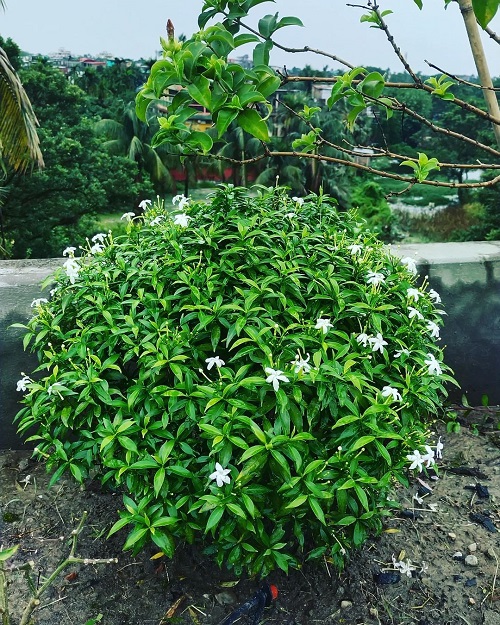
Location
Crepe Jasmine can be grown in full sun or partial shade. For best growth, spread, and flowers, make sure the plant gets a minimum of 4-6 hours of direct sunlight. It will also promote the size and fragrance of flowers.
Soil
Pinwheel Flowers grow really well in soil with pH 4.6-6.0. Make a potting mix by adding 30 percent compost and 70 percent garden soil. Also, if the soil in your area has high clay content, blend it by mixing 20 percent sand, 50 percent garden soil, and 30 percent compost to create the right balance of well-draining growing medium.
Water
This plant prefers moist soil but not waterlogged, so avoid overwatering. Water the pinwheel flower when the topsoil feels slightly dry to the touch. Poke your finger to check the moisture in the growing medium, or use a moisture meter.
Temperature
Pinwheel Jasmine is accustomed to tropical climates so that it won’t endure extreme cold or frost. During summer, keep the plant in an area where the temperature remains between 72-77 F (22-25 C), while in the winter, it has to be between 50-61 F (10-16 C). The blooms will last longer at low temperatures.
Look at the Vines with Pink Trumpet Flowers
Crepe Jasmine Care
Fertilizer
Feed the plant with balanced liquid fertilizer, diluted to half of its strength, once in 6-8 weeks. Avoid over-feeding the plant, as it may lead to the yellowing of foliage and plant decay.
Pruning
Prune the plant in the rainy season or in September and October – you can give it a small shape that resembles a tree. Trim lower branches; do not prune more than one-third of a plant.
Re-potting
While growing in pots, crepe jasmine becomes root-bound quickly. If the topsoil shows some roots, take the plant out of the pot and plant it in a bigger container. Also, use fresh potting soil.
Pests and Diseases
Crepe jasmine is susceptible to scales, nematodes, whiteflies, and sooty mold. It can also be attacked by caterpillars, especially the oleander hawk-moth.
Use neem oil spray to prevent insect attack. Mix 4-5 ml of neem oil and 2-3 drops of liquid. Hand wash soap in 1 liter of water, shake well and spray on the affected area.
Check out Vines with White Trumpet Flowers
Toxicity and Medicinal Uses
The pinwheel flower is from the Apocynaceae family and, like other plants from this genus, is also mildly toxic, resulting in upset stomach and mouth irritation if consumed. Keep it away from pets and children.
It has many medicinal uses in Ayurveda in India and Southeast Asian nations.



